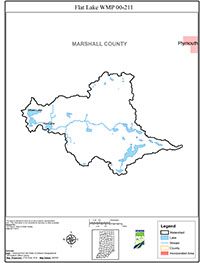Summary
With funding from the US Environmental Protection Agency through the Indiana Department of Environmental Management’s (IDEM) Section 319 grant program, the Poor Handmaids of Jesus Christ (PHJC) initiated the development of this watershed management plan (WMP). The geographic scope is the Flat Lake watershed. The Flat Lake watershed encompasses approximately 4,800 acres southwest of Plymouth, Indiana. The Flat Lake watershed is part of the larger Gunard Anderson-Carl Gjemre Ditches 14-digit watershed (07120001060070) which lies within the Kankakee River basin (07120001). This plan details the current and historical condition of the watershed. It documents the watershed stakeholders’ concerns and vision for the future of the Flat Lake watershed and the waterbodies that lie in it. The WMP also outlines the stakeholders’ strategies and action items selected to achieve their vision. Finally, the WMP includes methods for measuring stakeholders’ progress toward achieving their vision and timeframes for periodic refinement of the plan.
The PHJC initiated the development of this WMP plan in response to concerns over the ecological health of Gilbert Lake and its watershed. Fish kills in the mid-1970’s signaled a problem with the ecological balance of the lake and its watershed. Water quality testing conducted by IDEM in 1986 confirmed that there was a problem with Gilbert Lake. The results of that testing indicated that Gilbert Lake was hyper-eutrophic or overly productive. Gilbert Lake’s Eutrophication Index score was 75, which is the worst possible score. Lakes with a score of 75 are often described as being similar to “pea soup” since severe algae blooms are the norm on these lakes. Later testing conducted by the Indiana Clean Lakes Program (CLP) in the mid to late 1990’s found that water quality conditions in Gilbert Lake had improved, but still warranted concern.
Faced with this evidence, the PHJC began taking action to restore Gilbert Lake and its watershed. In the mid 1990’s, the PHJC requested that the Indiana Department of Natural Resources (IDNR) Lake and River Enhancement Program (LARE) conduct a study to help them better understand the condition of the lake and provide direction for its management. LARE staff conducted a preliminary diagnostic study on Gilbert Lake in 1997. With IDNR LARE Watershed Land Treatment funding, the PHJC completed a number of projects, many of which were recommendations from the diagnostic study. These projects include fencing cattle away from the lakeshore (1997); re-vegetating the east end of the lake (1997) and prohibiting mowing at the location; planting trees on the west end of the lake (1998); utilizing conservation tillage on all farmed acreage (since 1997); constructing a wetland above the inlet to Gilbert Lake (2000); installing a filter strip along the inlet to Gilbert Lake (2001); fencing livestock from the constructed wetland (2002); establishing a livestock watering facility (2003); implementing a conservation plan on all highly erodible land; and reducing the amount of fertilizers and herbicides used on the property. In addition to these Watershed Land Treatment projects, the PHJC also installed a wastewater wetland to treat the waste stream from the Earthworks facility located on the southern edge of Gilbert Lake. With funding from the same program that funded this plan, the PHJC restored 12 acres of wetland around Gilbert Lake’s outlet stream. This restoration included re-meandering the outlet stream and fencing the wetland’s perimeter to protect it from cattle grazing. Finally, the PHJC worked with state regulators to reroute the National Pollutant Discharge Elimination System (NPDES) permitted discharge from the PHJC wastewater lagoon from its original outlet to the lake to the restored wetland to provide additional post-discharge treatment for the wastewater. The PHJC are also currently working with the IDNR Division of Soil Conservation to install a grassed waterway upstream of Gilbert Lake.
While the PHJC is active in restoring Gilbert Lake and its watershed, they recognized the direct influence the condition of Gilbert Lake has on Flat Lake. Because of this connection, the PHJC broadened their efforts to include the landscape downstream of Gilbert Lake. The PHJC also recognized the need to include more people in the restoration efforts. This plan represents the collective effort of all the Flat Lake watershed stakeholders to make the watershed an ecologically healthy and attractive part of the landscape. All watershed property owners were invited to participate in development of this plan. Additionally, major stakeholders representing local, state, and federal natural resources agencies, including the IDNR Division of Soil Conservation Resource Specialist, the IDNR Menominee Wetland Conservation Area (WCA) Property Manager, IDEM’s Regional Watershed Coordinator; non-for-profit organizations such as Ducks Unlimited and the Sierra Club; and the local county planner were also invited to participate. Participation the plan’s development was encouraged though the use of quarterly mailings to announce public meetings and summarize the discussion and decisions made at these meetings. The quarterly meetings formed the foundation of the plan’s development. Stakeholders set goals, prioritized goals and decided on a course of action to achieve these goals in these public meetings.

